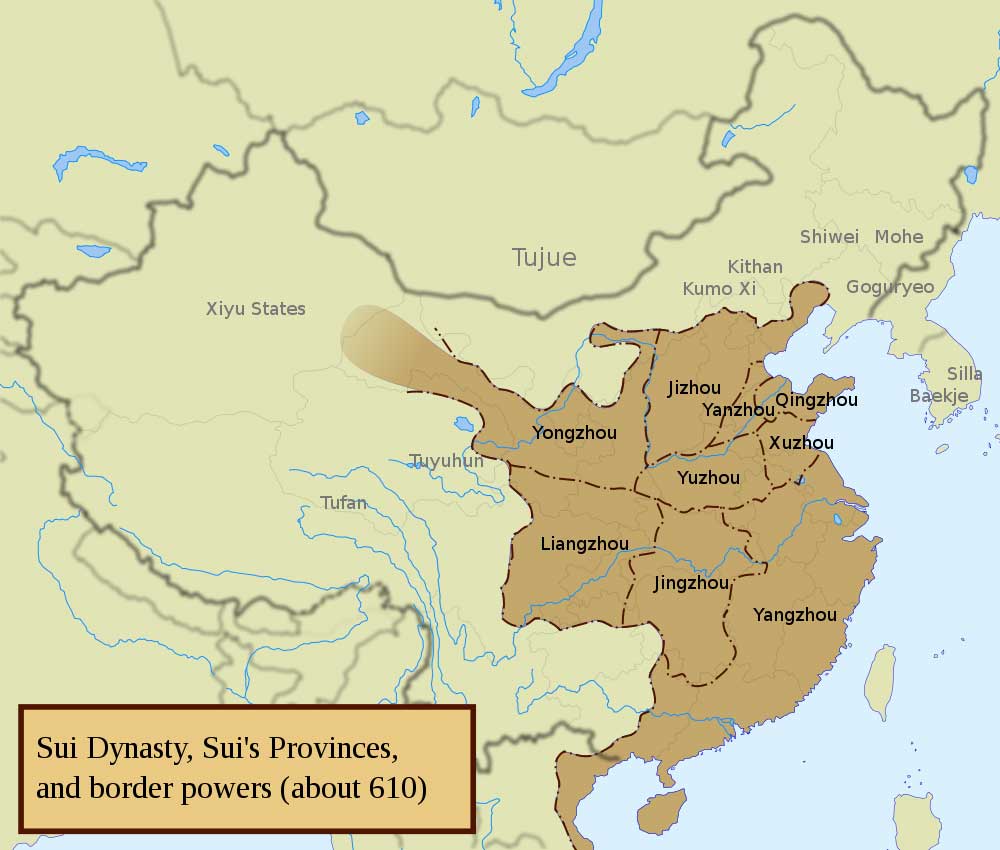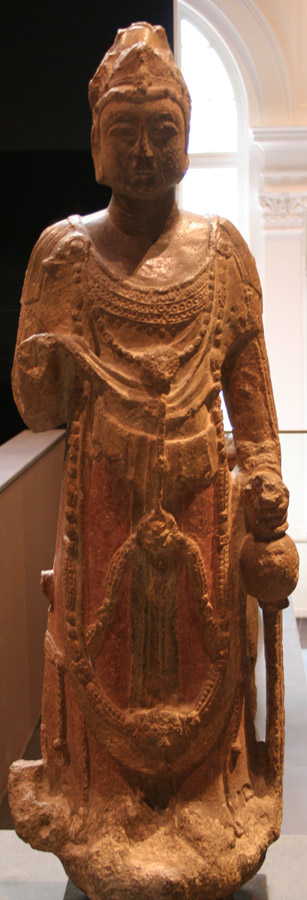China’s History can be seen as a conglomeration of eras alternating between political unity and disunity. Many ethnic cultures influenced China’s cultural and political view points due to large waves of immigration, cultural assimilation, and expansion of areas in Asian regions which today are part of modern China.
When the Northern Zhou defeated the Southern Zhou Dynasty in 577 CE, the northern Chinese finally defeated the south but the conquest was only delayed with civil war.
The Sui Dynasty and Its Developments
The Sui Dynasty (581-618) was a short lived Imperial Dynasty established by Emperor Wen of Sui where Luoyang had become the dynasty’s capital. Emperor Wen’s goals during his reign were the reunification of China’s Northern and Southern parts, the building of the Grand Canal, standardized currency and its unification in all of China, the institution of the Departments and the Six Ministries, and the improvement of the Great Wall as part of their defenses. Buddhism was encouraged and spread all over the empire to unify all of China’s different cultures and peoples, and the establishment of the Equifield system as part of Emperor Wen’s reform agenda to reduce the rich-poor social gap by increasing agricultural productivity which would support a centralized government power.
Buddhism has become the unifying force of all cultures in China. Buddhism started from India traveled to Afghanistan then to China brought through by Asian people through trade, migration, and cultural assimilation. Buddhism was responsible of the rebirth of China, its reunification during the Sui Dynasty. It gained importance during a period when the central political control was limited. Buddhism was used to unify the culture of China and uplift the cultural condition of the people during and after war and into the Sui Dynasty.
The Rise of Emperor Wen
The Sui Dynasty (581-618) started when the daughter of Emperor became the Empress of Northern Zhou. Emperor Wen, Zhou’s Prime Minister, forcibly took the throne after crushing an army at the eastern provinces and disarmed it. He then eliminated a lot of Zhou royal princes. He is famous as the “Cultured Emperor”.
As one of his reform agenda, Emperor Wen eliminated Zhou’s policies and regained Yang as his surname. Emperor Wen then initiated series of reforms that would unify China and strengthen his empire. He also won Confucian scholars’ admiration and support, who opposed the corruption and nepotism of the 9-rank system.
In defeating the Chen dynasty, Emperor Wen employed Xianbein, different ethnic groups in China, and Sichuan who are aborigines from the southeastern part of China which he recently conquered. This is one of Emperor Wen’s campaigns for southern invasion. Since the Chen’s Dynasty was in trouble, as it couldn’t withstand the force of Sui Dynasty, in 589 CE, the last Chen dynasty’s emperor submitted, thus its collapse. The downfall of the Chen dynasty was attributed to Sui Dynasty amassing of troops which totals to 518,000 by 588 CE and makes them the strongest military ever.
Wen and Economy
Even though Emperor Wen caused the bankruptcy of his empire due to warfare, construction projects and infrastructure improvements in the early part of his reign he has established food granaries in order to control the prices in the market – from crop taxation, just like the Han Dynasty.
Wen and Buddhism
Emperor Wen and his empress converted to Buddhism, accepted its values and culture and presented himself as the Buddhist monarch who uses military force in enforcing his will over his entire Empire to defend the Buddhist faith. Emperor Wen also rallies the culture of Buddhism, it values, among the people in his empire by distributing relics of Buddha and leaving messages for the people to think of and later on embrace the faith.
Wen’s Death and Eventual Decline of the Sui Dynasty
After Emperor Wen’s death by murder among his people, the Sui Dynasty (581-618) was continued by his son Emperor Yang of Sui. Not like his father who pushed for reforms as his main agenda, he was able to bring back the examination and education of bureaucrats. Also, he led a life of expensive and decadent luxury and his various costly construction projects including the Grand Canal of China’s construction, invasion of the Turkic nomads, he lost support from the public and trust and was eliminated by his ministers.
The decline of power of the Sui Dynasty was greatly attributed to Emperor’s Wen and Yang numerous military expedition, expensive infrastructure projects, and their high living standards at the expense of the peasants and the people of China. One of the massive expeditions was the invasion of Goguryeu in the Korean Peninsula, which is one of the three Kingdoms in Korea. This expedition has the most number of armies, artilleries, and mounds of equipment. It even took them 30 days to assemble.
Even with their vast number and equipment, Emperor Yang of Sui and his soldiers were overpowered by the famous leader Eulji Mundeok of Goguryeo. Aside from the military tactic of Goguryeo’s famous army leader, Sui’s soldiers did not withstand the cold weather and many died from hunger and frostbite.
Even though the Sui Dynasty was short-lived, Emperor Wen contributed much to the culture of China and with the introduction of Buddhism as their unifying force, this religion became China’s stronghold of faith among its people. With Sui Dynasty the Northern and Southern part of China was reunified which contributed to the success of the Tang Dynasty. China has faced numerous political controls over all of the Dynasties which make its unity and disunity a part of Chin’s history and culture.

